Abstract
Serotonin (5-hydroxytryptamine, 5-HT) has been shown to be a neurotransmitter in the enteric nervous system (ENS). Although 5-HT is a mediator of slow excitatory postsynaptic potentials evoked by stimulation of interganglionic connectives, the precise role it plays in the physiology of the gut is unclear. Research has been hampered by an inadequate knowledge of the types of 5-HT receptor in the ENS and thus the lack of well-characterized antagonists. We now report the identification of two classes of enteric neural 5-HT receptor, the effects of activating these receptors on myenteric type II/AH neurons, and their characterization with specific agonists and antagonists. One class, which we propose to call 5-HT1P, is characterized by a high affinity for [3H]5-HT in radioligand binding assays. This class of receptor mediates a slow depolarization of myenteric type II/AH neurons associated with an increase in input resistance. Agonists at this receptor include, in addition to 5-HT (in order of potency), 5- and 6-hydroxyindalpine and 2-methyl-5-HT. 5-HT1P-mediated responses are specifically antagonized by 5-hydroxytryptophyl-5-hydroxytryptophan amide. The other class of 5-HT receptor, which we propose to call 5-HT2P, appears not to have a high affinity for [3H]5-HT. This receptor mediates a brief depolarization of myenteric II/AH neurons associated with a fall in input resistance. 2-Methyl-5-HT, at low concentrations, is a specific agonist at this receptor and ICS 205-930 is a specific antagonist. Binding of [3H]5-HT to enteric membranes is inhibited by 5-HT1P receptor agonists and antagonists but not by the 5-HT2P receptor antagonist ICS 205-930 or by MDL 72222, another compound reported to be an antagonist of 5-HT at peripheral receptors.
Full text
PDF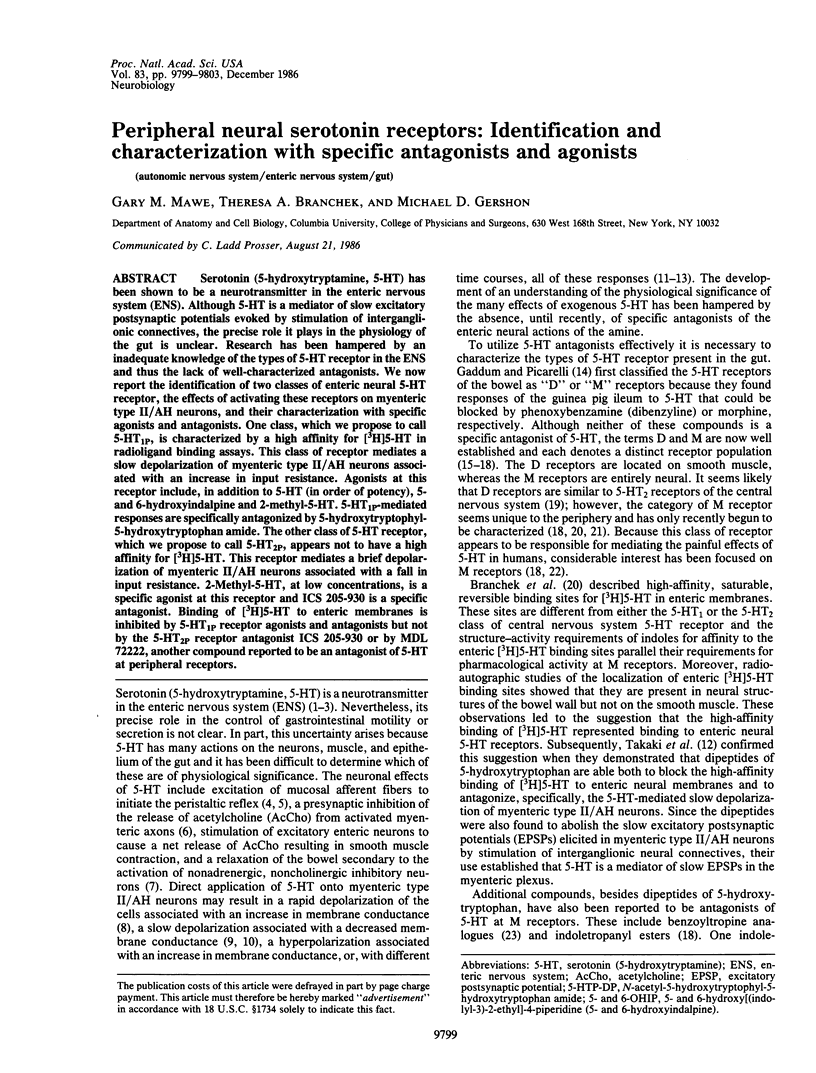
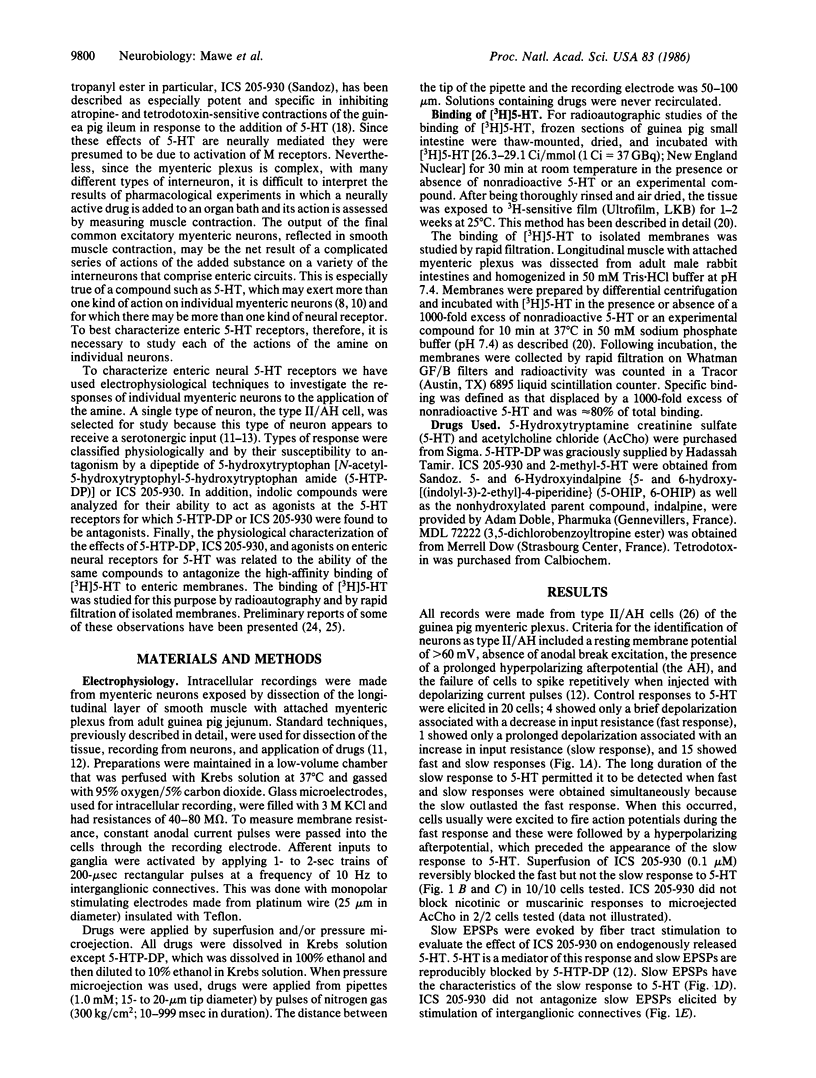
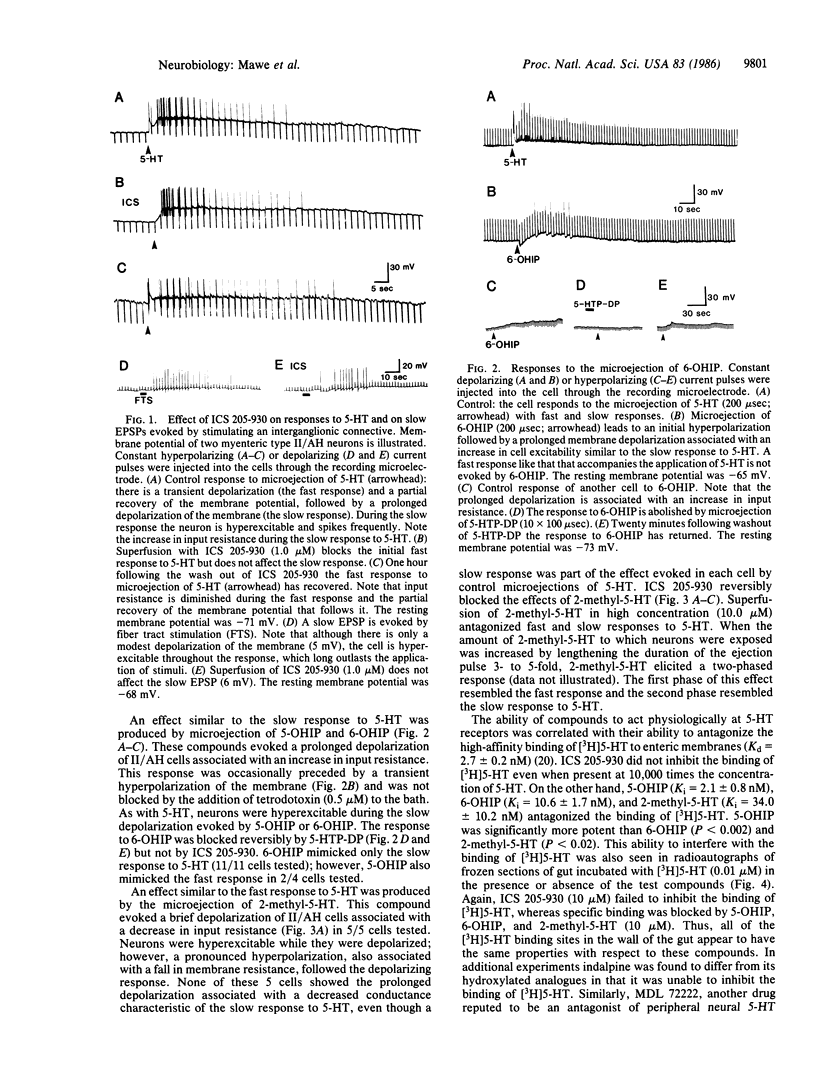
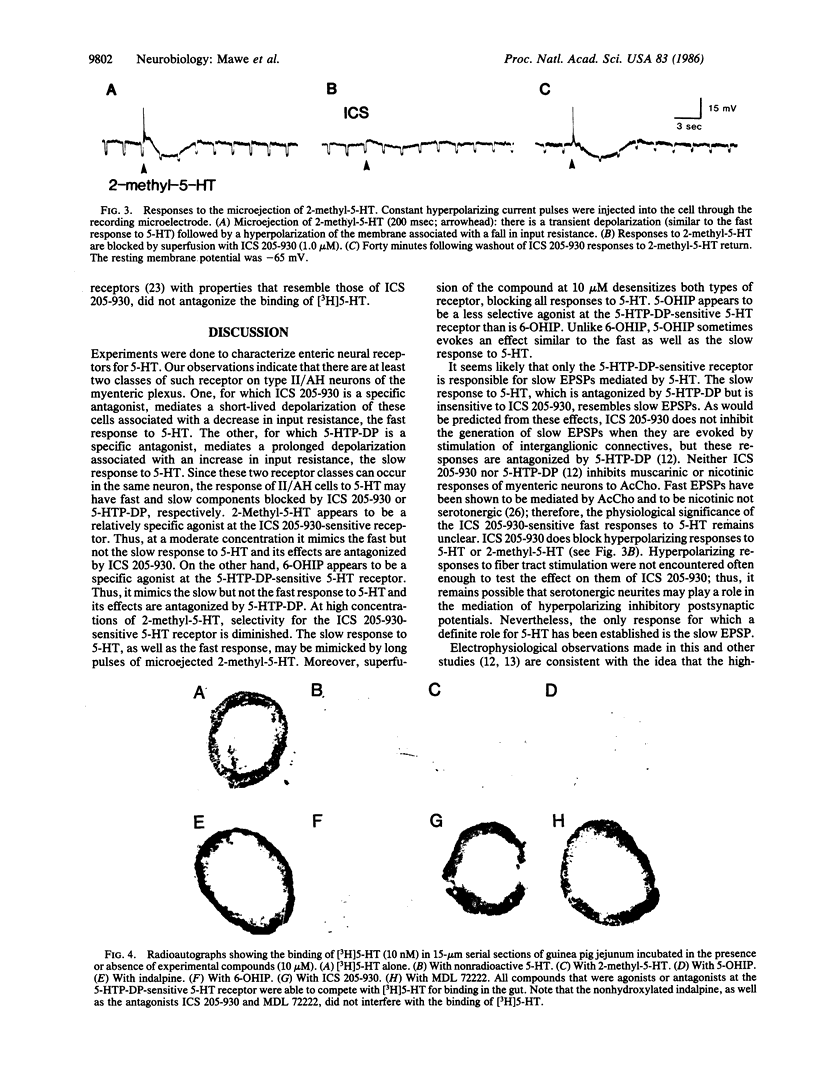
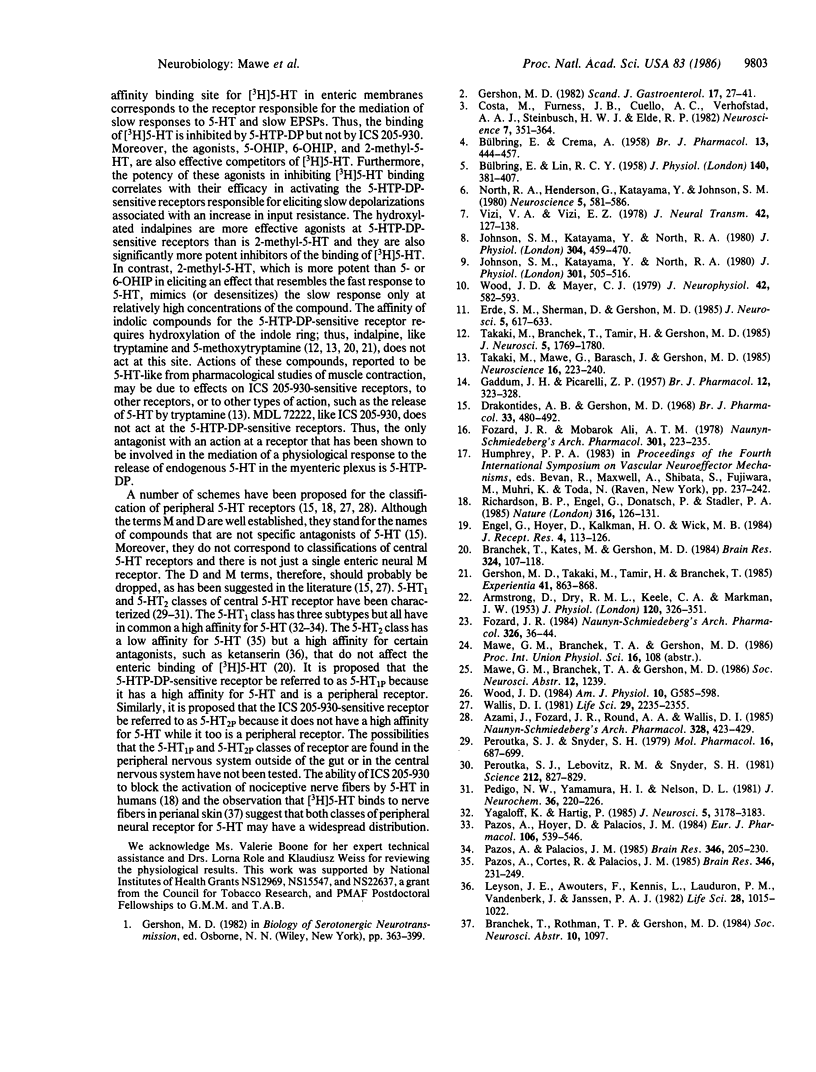
Images in this article
Selected References
These references are in PubMed. This may not be the complete list of references from this article.
- ARMSTRONG D., DRY R. M. L., KEELE C. A., MARKHAM J. W. Observations on chemical excitants of cutaneous pain in man. J Physiol. 1953 May 28;120(3):326–351. doi: 10.1113/jphysiol.1953.sp004898. [DOI] [PMC free article] [PubMed] [Google Scholar]
- Adám-Vizi V., Vizi E. S. Direct evidence of acetylcholine releasing effect of serotonin in the Auerbach plexus. J Neural Transm. 1978;42(2):127–138. doi: 10.1007/BF01675351. [DOI] [PubMed] [Google Scholar]
- Azami J., Fozard J. R., Round A. A., Wallis D. I. The depolarizing action of 5-hydroxytryptamine on rabbit vagal primary afferent and sympathetic neurones and its selective blockade by MDL 72222. Naunyn Schmiedebergs Arch Pharmacol. 1985 Feb;328(4):423–429. doi: 10.1007/BF00692911. [DOI] [PubMed] [Google Scholar]
- BULBRING E., CREMA A. Observations concerning the action of 5-hydroxytryptamine on the peristaltic reflex. Br J Pharmacol Chemother. 1958 Dec;13(4):444–457. doi: 10.1111/j.1476-5381.1958.tb00236.x. [DOI] [PMC free article] [PubMed] [Google Scholar]
- BULBRING E., LIN R. C. The effect of intraluminal application of 5-hydroxytryptamine and 5-hydroxytryptophan on peristalsis; the local production of 5-HT and its release in relation to intraluminal pressure and propulsive activity. J Physiol. 1958 Mar 11;140(3):381–407. [PMC free article] [PubMed] [Google Scholar]
- Branchek T., Kates M., Gershon M. D. Enteric receptors for 5-hydroxytryptamine. Brain Res. 1984 Dec 17;324(1):107–118. doi: 10.1016/0006-8993(84)90627-9. [DOI] [PubMed] [Google Scholar]
- Costa M., Furness J. B., Cuello A. C., Verhofstad A. A., Steinbusch H. W., Elde R. P. Neurons with 5-hydroxytryptamine-like immunoreactivity in the enteric nervous system: their visualization and reactions to drug treatment. Neuroscience. 1982 Feb;7(2):351–363. doi: 10.1016/0306-4522(82)90272-x. [DOI] [PubMed] [Google Scholar]
- Drakontides A. B., Gershon M. D. 5-hydroxytryptamine receptors in the mouse duodenum. Br J Pharmacol Chemother. 1968 Jul;33(3):480–492. doi: 10.1111/j.1476-5381.1968.tb00496.x. [DOI] [PMC free article] [PubMed] [Google Scholar]
- Engel G., Hoyer D., Kalkman H. O., Wick M. B. Identification of 5HT2-receptors on longitudinal muscle of the guinea pig ileum. J Recept Res. 1984;4(1-6):113–126. doi: 10.3109/10799898409042543. [DOI] [PubMed] [Google Scholar]
- Erde S. M., Sherman D., Gershon M. D. Morphology and serotonergic innervation of physiologically identified cells of the guinea pig's myenteric plexus. J Neurosci. 1985 Mar;5(3):617–633. doi: 10.1523/JNEUROSCI.05-03-00617.1985. [DOI] [PMC free article] [PubMed] [Google Scholar]
- Fozard J. R., Ali A. T. Receptors for 5-hydroxytryptamine on the sympathetic nerves of the rabbit heart. Naunyn Schmiedebergs Arch Pharmacol. 1978 Jan-Feb;301(3):223–235. doi: 10.1007/BF00507041. [DOI] [PubMed] [Google Scholar]
- Fozard J. R. MDL 72222: a potent and highly selective antagonist at neuronal 5-hydroxytryptamine receptors. Naunyn Schmiedebergs Arch Pharmacol. 1984 May;326(1):36–44. doi: 10.1007/BF00518776. [DOI] [PubMed] [Google Scholar]
- GADDUM J. H., PICARELLI Z. P. Two kinds of tryptamine receptor. Br J Pharmacol Chemother. 1957 Sep;12(3):323–328. doi: 10.1111/j.1476-5381.1957.tb00142.x. [DOI] [PMC free article] [PubMed] [Google Scholar]
- Gershon M. D. Serotonergic neurotransmission in the gut. Scand J Gastroenterol Suppl. 1982;71:26–41. [PubMed] [Google Scholar]
- Gershon M. D., Takaki M., Tamir H., Branchek T. The enteric neural receptor for 5-hydroxytryptamine. Experientia. 1985 Jul 15;41(7):863–868. doi: 10.1007/BF01970002. [DOI] [PubMed] [Google Scholar]
- Johnson S. M., Katayama Y., North R. A. Multiple actions of 5-hydroxytryptamine on myenteric neurones of the guinea-pig ileum. J Physiol. 1980 Jul;304:459–470. doi: 10.1113/jphysiol.1980.sp013336. [DOI] [PMC free article] [PubMed] [Google Scholar]
- Johnson S. M., Katayama Y., North R. A. Slow synaptic potentials in neurones of the myenteric plexus. J Physiol. 1980 Apr;301:505–516. doi: 10.1113/jphysiol.1980.sp013220. [DOI] [PMC free article] [PubMed] [Google Scholar]
- Leysen J. E., Awouters F., Kennis L., Laduron P. M., Vandenberk J., Janssen P. A. Receptor binding profile of R 41 468, a novel antagonist at 5-HT2 receptors. Life Sci. 1981 Mar 2;28(9):1015–1022. doi: 10.1016/0024-3205(81)90747-5. [DOI] [PubMed] [Google Scholar]
- North R. A., Henderson G., Katayama Y., Johnson S. M. Electrophysiological evidence for presynaptic inhibition of acetylcholine release by 5-hydroxytryptamine in the enteric nervous system. Neuroscience. 1980;5(3):581–586. doi: 10.1016/0306-4522(80)90055-x. [DOI] [PubMed] [Google Scholar]
- Pazos A., Cortés R., Palacios J. M. Quantitative autoradiographic mapping of serotonin receptors in the rat brain. II. Serotonin-2 receptors. Brain Res. 1985 Nov 4;346(2):231–249. doi: 10.1016/0006-8993(85)90857-1. [DOI] [PubMed] [Google Scholar]
- Pazos A., Hoyer D., Palacios J. M. The binding of serotonergic ligands to the porcine choroid plexus: characterization of a new type of serotonin recognition site. Eur J Pharmacol. 1984 Nov 27;106(3):539–546. doi: 10.1016/0014-2999(84)90057-8. [DOI] [PubMed] [Google Scholar]
- Pazos A., Palacios J. M. Quantitative autoradiographic mapping of serotonin receptors in the rat brain. I. Serotonin-1 receptors. Brain Res. 1985 Nov 4;346(2):205–230. doi: 10.1016/0006-8993(85)90856-x. [DOI] [PubMed] [Google Scholar]
- Pedigo N. W., Yamamura H. I., Nelson D. L. Discrimination of multiple [3H]5-hydroxytryptamine binding sites by the neuroleptic spiperone in rat brain. J Neurochem. 1981 Jan;36(1):220–226. doi: 10.1111/j.1471-4159.1981.tb02397.x. [DOI] [PubMed] [Google Scholar]
- Peroutka S. J., Lebovitz R. M., Snyder S. H. Two distinct central serotonin receptors with different physiological functions. Science. 1981 May 15;212(4496):827–829. doi: 10.1126/science.7221567. [DOI] [PubMed] [Google Scholar]
- Peroutka S. J., Snyder S. H. Multiple serotonin receptors: differential binding of [3H]5-hydroxytryptamine, [3H]lysergic acid diethylamide and [3H]spiroperidol. Mol Pharmacol. 1979 Nov;16(3):687–699. [PubMed] [Google Scholar]
- Richardson B. P., Engel G., Donatsch P., Stadler P. A. Identification of serotonin M-receptor subtypes and their specific blockade by a new class of drugs. Nature. 1985 Jul 11;316(6024):126–131. doi: 10.1038/316126a0. [DOI] [PubMed] [Google Scholar]
- Takaki M., Branchek T., Tamir H., Gershon M. D. Specific antagonism of enteric neural serotonin receptors by dipeptides of 5-hydroxytryptophan: evidence that serotonin is a mediator of slow synaptic excitation in the myenteric plexus. J Neurosci. 1985 Jul;5(7):1769–1780. doi: 10.1523/JNEUROSCI.05-07-01769.1985. [DOI] [PMC free article] [PubMed] [Google Scholar]
- Takaki M., Mawe G. M., Barasch J. M., Gershon M. D., Gershon M. D. Physiological responses of guinea-pig myenteric neurons secondary to the release of endogenous serotonin by tryptamine. Neuroscience. 1985 Sep;16(1):223–240. doi: 10.1016/0306-4522(85)90059-4. [DOI] [PubMed] [Google Scholar]
- Wallis D. Neuronal 5-hydroxytryptamine receptors outside the central nervous system. Life Sci. 1981 Dec 7;29(23):2345–2355. doi: 10.1016/0024-3205(81)90470-7. [DOI] [PubMed] [Google Scholar]
- Wood J. D., Mayer C. J. Serotonergic activation of tonic-type enteric neurons in guinea pig small bowel. J Neurophysiol. 1979 Mar;42(2):582–593. doi: 10.1152/jn.1979.42.2.582. [DOI] [PubMed] [Google Scholar]
- Yagaloff K. A., Hartig P. R. 125I-lysergic acid diethylamide binds to a novel serotonergic site on rat choroid plexus epithelial cells. J Neurosci. 1985 Dec;5(12):3178–3183. doi: 10.1523/JNEUROSCI.05-12-03178.1985. [DOI] [PMC free article] [PubMed] [Google Scholar]




